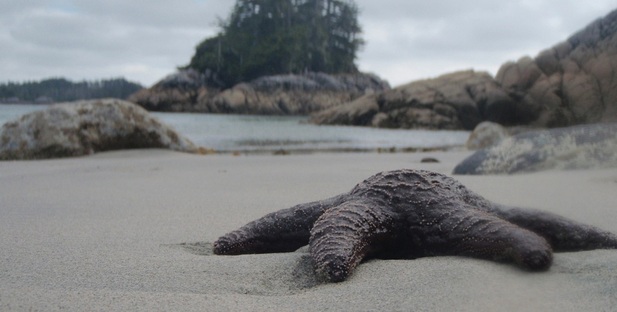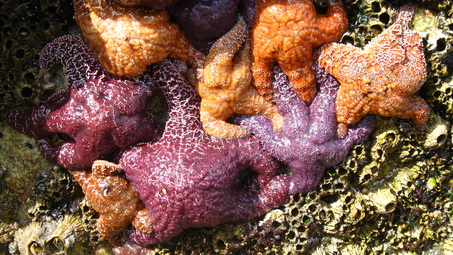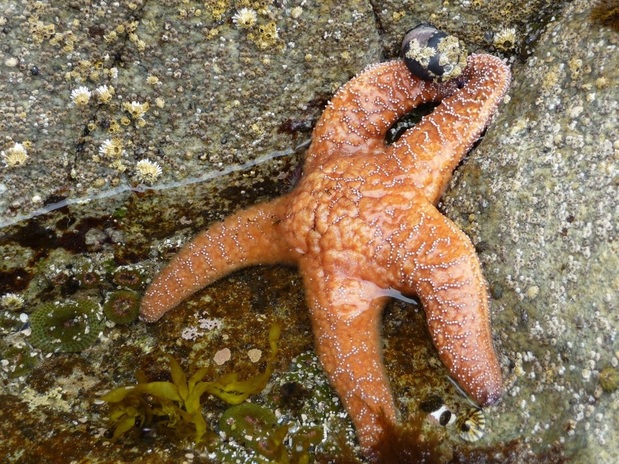Ochre star, purple sea star, common sea star • Pisaster ochraceus • Heiltsuk/Haíɫzaqv - ǧázax̌ • Nuxalk - qatsx
Photos by Chanda Brietzke (right), Brian Starzomski (top left), and Julia Fisher.
Identification
The ochre star can be purple, yellow, or brown, marked by a characteristic web-like array of white spines. It generally has 5 arms, and can grow to 36 cm in diameter.
Habitat & Range
The ochre star is ubiquitous on the Pacific Coast from Alaska to California. It is abundant in the intertidal, often clustering together (see top left photo), usually on rocks or in mussel beds up to depths of 87 m.
Similar Species
This species can be mistaken for the mottled star (Evasterias troschelii), however the ochre star has much shorter arms, a larger central disc, and more prominent spines.
Intriguing Info
The ochre star can live for 20 years or more, which likely makes it the longest-living sea star in the Pacific Northwest. Sea stars feed on stationary (sessile) or slow-moving species like barnacles, limpets, snails and mussels. Like other sea stars, it everts its stomach to outside its body and around its prey. Digestion begins outside the body, then the stomach and partially digested organisms are retracted back into the body where digestion continues. The stomach can even be inserted into shells to get at the fleshy animal inside; click here to see a video of a mussel being eaten by an ochre star, from the mussel's point of view.
The ochre star plays an important role as a keystone species in the rocky intertidal throughout its range, due to its predation on the California mussel (Mytilus californianus) and other intertidal invertebrates. Click here to learn more.
A massive die-off of sea stars, including the ochre star, began in summer 2013 along the Pacific Coast of North America, as a result of a disease called Sea Star Wasting Syndrome which is thought to be caused by a densovirus. Learn more about the ochre star and Sea Star Wasting Disease on the Pacific Rocky Intertidal Monitoring species page.
iNaturalist
https://www.inaturalist.org/taxa/49699-Pisaster-ochraceus
The ochre star can be purple, yellow, or brown, marked by a characteristic web-like array of white spines. It generally has 5 arms, and can grow to 36 cm in diameter.
Habitat & Range
The ochre star is ubiquitous on the Pacific Coast from Alaska to California. It is abundant in the intertidal, often clustering together (see top left photo), usually on rocks or in mussel beds up to depths of 87 m.
Similar Species
This species can be mistaken for the mottled star (Evasterias troschelii), however the ochre star has much shorter arms, a larger central disc, and more prominent spines.
Intriguing Info
The ochre star can live for 20 years or more, which likely makes it the longest-living sea star in the Pacific Northwest. Sea stars feed on stationary (sessile) or slow-moving species like barnacles, limpets, snails and mussels. Like other sea stars, it everts its stomach to outside its body and around its prey. Digestion begins outside the body, then the stomach and partially digested organisms are retracted back into the body where digestion continues. The stomach can even be inserted into shells to get at the fleshy animal inside; click here to see a video of a mussel being eaten by an ochre star, from the mussel's point of view.
The ochre star plays an important role as a keystone species in the rocky intertidal throughout its range, due to its predation on the California mussel (Mytilus californianus) and other intertidal invertebrates. Click here to learn more.
A massive die-off of sea stars, including the ochre star, began in summer 2013 along the Pacific Coast of North America, as a result of a disease called Sea Star Wasting Syndrome which is thought to be caused by a densovirus. Learn more about the ochre star and Sea Star Wasting Disease on the Pacific Rocky Intertidal Monitoring species page.
iNaturalist
https://www.inaturalist.org/taxa/49699-Pisaster-ochraceus
References
Harbo, R. M. (1999). Whelks to whales: Coastal marine life of the Pacific Northwest. Madeira Park, BC: Harbour Publishing. P. 136.
Authors and editors of page
Chanda Brietzke, Kelly Fretwell, and Brian Starzomski (2013).
Harbo, R. M. (1999). Whelks to whales: Coastal marine life of the Pacific Northwest. Madeira Park, BC: Harbour Publishing. P. 136.
Authors and editors of page
Chanda Brietzke, Kelly Fretwell, and Brian Starzomski (2013).







